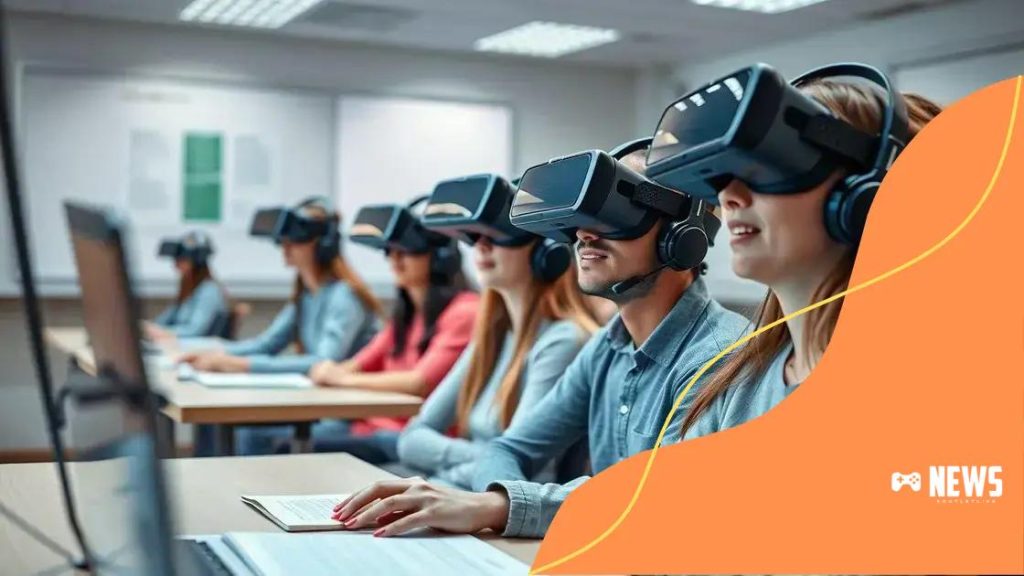Virtual reality classrooms: the new way to learn

Virtual reality classrooms enhance engagement and learning by providing immersive experiences, personalized learning paths, and global collaboration opportunities, preparing students for the future of education.
Imagine stepping into a world where learning comes alive—this is the promise of virtual reality classrooms. By merging technology with education, students can experience subjects in ways that were previously unimaginable. Curious about how this can change the way we learn? Let’s dive in.
Understanding virtual reality in education
Understanding virtual reality in education is crucial for harnessing its full potential. With the advancement of technology, educators now have the opportunity to create engaging learning experiences that capture students’ imaginations. Virtual reality allows learners to step into immersive environments that enhance understanding and retention.
What is Virtual Reality in Education?
Virtual reality in education refers to the use of VR technology to create simulated environments where students can interact with their surroundings. These experiences can provide a hands-on approach to learning complex subjects, such as science, history, and the arts. By wearing VR headsets, students can explore locations they may never visit and interact with content in a three-dimensional space.
Benefits of Virtual Reality in the Classroom
- Increased engagement: Students become more involved when learning is enjoyable and interactive.
- Improved retention: When learners experience information, they are more likely to remember it.
- Access to diverse experiences: Students can explore different cultures and historical events without leaving the classroom.
- Enhanced collaboration: Virtual environments can foster teamwork and communication skills among students.
The possibilities of virtual reality in education are vast. It transforms traditional learning into an adventure where students are active participants. For instance, imagine a biology class where students can explore the human body from the inside or a history lesson that transports them back to ancient civilizations. Such experiences create lasting memories and deepen understanding.
Moreover, there are various platforms available, making it easier for educators to integrate VR into their teaching methodologies. These platforms often provide a user-friendly interface, allowing teachers to select or create content that aligns with their curriculum.
In essence, understanding virtual reality in education is about recognizing its potential to revolutionize how we teach and learn. Embracing this technology can lead to transformative educational experiences that prepare students for the future.
Benefits of immersive learning environments
The benefits of immersive learning environments are numerous and impactful. These settings enhance the learning experience by engaging students in ways traditional classrooms cannot. By using immersive technologies, educators can create rich, interactive experiences that captivate learners’ attention.
Enhanced Engagement
One of the primary advantages of immersive learning is the increased engagement it fosters. When students are fully immersed in their learning, they are less likely to be distracted. This focused attention can lead to higher levels of comprehension and retention of information.
Real-World Application
Immersive environments allow students to apply their knowledge in practical scenarios. For example, in a virtual chemistry lab, students can conduct experiments safely and see the results without the risk of physical hazards. This hands-on approach helps them understand concepts better.
- Promotes critical thinking skills
- Encourages collaborative learning experiences
- Provides access to diverse educational resources
- Helps build confidence in practical skills
Furthermore, immersive learning environments can foster collaboration among students. When working together in virtual spaces, they can share ideas and solutions, enhancing teamwork and communication skills. These skills are essential for success in today’s workforce.
This kind of learning also provides a safe space for students to make mistakes and learn from them, boosting their confidence. The ability to repeat experiences without real-world consequences empowers students to experiment and discover new concepts.
In conclusion, the benefits of immersive learning environments create exciting new opportunities in education. These environments make learning more engaging, applicable, and enjoyable for students, preparing them for real-world challenges.
Challenges of implementing VR in classrooms

Implementing virtual reality in classrooms comes with various challenges that educators must navigate. While the technology offers exciting opportunities for immersive learning, several factors can hinder its effective use in education.
Cost Considerations
One of the biggest barriers is the cost associated with VR technology. Schools often struggle with budgets, and investing in VR equipment can be costly. This includes not just the headsets, but also the necessary hardware and software to support these experiences.
Training for Educators
Another challenge is providing adequate training for teachers. Many educators may not be familiar with virtual reality technology, which can lead to resistance in adoption. Proper training programs are essential to ensure that teachers can confidently incorporate VR into their lessons.
- Time to learn new technology
- Need for continuous professional development
- Awareness of best practices in VR teaching
- Access to resources and lesson plans
Additionally, there might be tech-related issues such as software glitches or hardware malfunctions. These unexpected challenges can disrupt lessons and lead to frustration among both students and teachers. It is crucial for schools to have technical support readily available to resolve these issues swiftly.
Moreover, integrating VR into existing curricula requires thoughtful planning. Educators must determine how to align virtual experiences with learning objectives. This can be complex as they seek to make every VR session meaningful and educational.
Finally, not all students may respond positively to virtual reality learning. While many enjoy immersive experiences, others may feel uncomfortable or get motion sickness. This inconsistency in student experience can pose further challenges in creating an inclusive learning environment.
Successful VR classroom case studies
Successful VR classroom case studies highlight the effectiveness of virtual reality in education. Many schools and institutions around the world have embraced this technology and experienced remarkable outcomes.
Case Study: Immersive Science Learning
One notable example is a high school that incorporated VR into its science curriculum. Students engaged in virtual field trips to the Amazon rainforest, exploring biodiversity. This immersive experience enhanced their understanding of ecology and conservation. The skillful integration of VR led to increased student interest in environmental science.
Case Study: Historical Exploration
Another case features a middle school using virtual reality to teach history. Students visited ancient Rome through VR simulations. This interactive journey allowed them to walk through the Forum and learn about Roman culture firsthand. Feedback indicated that students felt more connected to the material and showed improved performance on assessments.
- High engagement levels among students
- Improved test scores and retention rates
- Increased curiosity and questions during lessons
- Greater collaboration among peers during group activities
Moreover, a university piloted a VR program in medical training. Students performed virtual surgeries, giving them a chance to practice their skills without the risks associated with real-life procedures. This approach not only increased their confidence but also prepared them better for clinical practice.
These successful case studies illustrate how VR can transform traditional learning environments. By leveraging immersive technology, educators can create unforgettable experiences that enhance both comprehension and collaboration.
The future of education with virtual reality
The future of education with virtual reality holds exciting possibilities for how we teach and learn. As technology advances, it opens new doors for creating engaging and effective learning environments.
Personalized Learning Experiences
One significant aspect of future education is the potential for personalized learning. VR can adapt to individual student needs and learning paces. Imagine a student exploring complex mathematical concepts through interactive simulations tailored to their skill level. This customization encourages deeper understanding and boosts confidence.
Global Classrooms
With virtual reality, classrooms are no longer bound by geography. Students can connect with peers from around the world in virtual spaces. This global interaction fosters cultural awareness and collaboration. For instance, students in one country could work on a project with classmates in another, learning from each other’s perspectives.
- Virtual exchanges enhance language skills
- Increased empathy through shared experiences
- Exposure to diverse cultures and ideas
- Collaboration on real-world problems
Moreover, as VR technology becomes more integrated into various subjects, teachers will evolve their teaching methods. They will design lessons that actively engage students, using immersive scenarios to illustrate concepts. For example, history lessons might transport students to significant events, allowing them to experience history firsthand.
Additionally, the future of education with virtual reality includes improved accessibility. Students with disabilities can benefit from tailored VR experiences that cater to their specific needs. This can lead to more inclusive classrooms where every learner has the opportunity to succeed.
In essence, the future of education with virtual reality paints a vibrant picture of a world where learning is accessible, engaging, and interconnected. As educators embrace this technology, they will shape more dynamic and effective learning experiences for all students.
The future of education with virtual reality is bright and full of potential. As technology continues to evolve, we can expect classrooms to become more engaging and personalized. With VR, students can experience learning in entirely new ways, breaking down geographical barriers and fostering collaboration. The benefits of immersive learning are vast, making education more inclusive and accessible for all learners. Educators are excited to embrace these opportunities, transforming traditional lessons into dynamic experiences that prepare students for a rapidly changing world.
\n\n
\n
FAQ – Frequently Asked Questions about Virtual Reality in Education
What are the main benefits of using VR in classrooms?
The main benefits include enhanced engagement, personalized learning experiences, and improved understanding of complex subjects.
How can VR make education more accessible?
Virtual reality can cater to diverse learning needs and provide safe environments for students with disabilities to learn and interact.
What challenges do schools face when implementing VR technology?
Challenges include high costs, the need for teacher training, equipment maintenance, and potential technical issues.
How does VR prepare students for the future?
By providing immersive experiences and interactive learning, VR helps students develop critical thinking, collaboration, and problem-solving skills required for the workforce.





